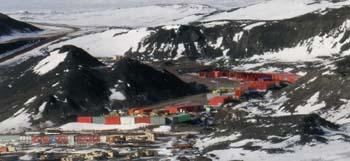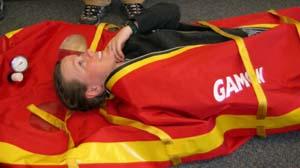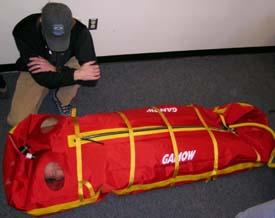
|
|
21 November, 2003
Living at High Altitude
Every day should start with a talk about Waste Management! In the most
bizarre class we have had yet, I learned about McMurdo’s waste
management system. I am actually rather impressed by this system.
Considering that approximately 1,000 people pass through the tiny town
of McMurdo in the summer months, there is a streamlined system of waste
management here. It starts small in the kitchen with bright signs
labeled “Food Waste Only” or “Burnables” (Figure 1). From there is
branches out into garbage stations with bins for “Aluminum,” “Plastics,”
“Glass,” “Computer Debris,” “Biohazard,” “Lab Waste,” “Mixed Paper,”
etc.. Finally, outside the buildings are large dumpsters (Figure 2)
ranging from “Food Waste” to “Old Clothing” to “Mixed Waste”
(construction debris). 100% of the waste generated in Antarctica leaves
Antarctica for processing. Large cargo bins (Figure 3) are used to
transport waste by cargo ship to Washington state.
All waste generated in the field must be separated in the same manner.
This made us thankful that while sorting food yesterday, we tried to
minimize packaging materials by repacking items in ziplock bags. All
waste that is generated in the field is carried back out – whether it be
food, fuel, or human waste.
From “Waste Management School,” we moved onto “High Altitude School.”
In this class we learned more about the challenges of working at
altitude. Mt. Erebus is 12, 448 feet high (3794 meters), so it poses
some unique challenges and risks. While the concentration of oxygen in
the air remains the same (21%) at high elevations, the number of
individual molecules available in each breath you take decreases (there
is lower air pressure at elevation). Because you take in fewer oxygen
molecules with each breath at elevation, the rate of diffusion (the
transport of molecules across a cell membrane from areas of high
concentration to low concentration) decreases between your lungs and red
blood cells. This means that your blood is carrying less oxygen, a
condition called hypoxia. Acute Mountain Sickness (AMS) is the most
frequent illness encountered when working at high altitude. AMS is
caused by hypoxia and is characterized by headache, fatigue, shortness
of breath, nausea, dizziness, and loss of appetite. Extreme cases may
even result in the loss of coordination and a decline in mental status
(confusion, irrational behavior or loss of consciousness). The best way
to prevent AMS is to rest, eat well, stay well hydrated, and take the
time to acclimatize.
In order to better acclimatize, our team will be spending two nights in
a camp on the Fang Glacier at approximately 9,000 feet before heading to
the top of Erebus. Even with this mandatory stop, we have to take it
easy on our way up Erebus. While Erebus is only about 12,000 feet high,
the atmosphere at the poles is thinner than at the equator, so the
physiological altitude (“feels like” altitude) is closer to 14,000 feet.
This is considered Very High elevation (as opposed to Mt. Marcy in the
Adirondacks, NY, which would be High Elevation or Mt. Everest which is
considered Extreme Elevation).
More severe illness encountered at high elevations include High Altitude
Cerebral Edema (HACE) and High Altitude Pulmonary Edema (HAPE). Both of
these conditions involve fluid leakage (in the brain and lungs
respectively) and can be fatal if untreated. Severe headache, loss of
coordination, vomiting, decreased mental status, shortness of breath at
rest, cyanosis (blue tinged lips and nail beds), and a cough with frothy
pink fluid are all signs that AMS has progressed to something more
severe. The only real treatment for HACE, HAPE, and severe AMS is to
descend in elevation. Oxygen and medications help to lessen the
symptoms, but an individual in this condition needs medical treatment.
Several of us were left wondering at this point “What if the weather is
bad and we can’t get a helicopter flight off of Erebus?” To our relief,
we discovered that there is, in fact, a back-up plan in the event that a
person suffering from HACE or HAPE is stuck on location and cannot
descend. A Gamow Bag is a device that can be used to temporarily
simulate lower altitude by increasing air pressure. I had the
opportunity to experience this device first hand during our High
Altitude Class.
The patient goes into the Gamow bag with a sleeping pad, sleeping bag,
book, water bottle, etc. to keep him/her comfortable for the next hour
or more (Figure 4). A one way, airtight zipper seals the person into the
bag (Figure 5). Our instructor directed our attention to a sealed
envelope that you must give to the person as they enter the bag. In the
envelope is a razor blade. Once you enter the bag, the bag is
pressurized and the zipper only opens from the outside. If two people
are at elevation together and one has to go into the Gamow bag, he/she
needs to be able to escape should their partner get hurt, pass out, etc.
A consideration that few of us thought about before it was pointed out
to us!
Before starting the Gamow bag demo, we synchronized two altimeter
watches to read 310 m (1000 ft) above sea level for the classroom. Once
I was comfortably in the bag, another student used a bellows foot pump
to gradually increase air pressure. In no time, I needed to clear my
ears and a glance at my altimeter told me that the pressure in the bag
had increased as though I had descended 200 m in elevation (Figure 6). A
few more minutes and I had “descended” to the equivalent of –165 m and
was at a pressure of 0.5 psi (pounds per square inch). The bag was
stretched tight (Figure 7) and the relief valves occasionally vented air
as it is important to keep the air circulating to flush carbon dioxide
out of the bag. For a HACE or HAPE victim, you would increase the
pressure to 2 psi and could simulate a descent of 5,000-6,000 feet of
elevation.
Once the class had seen how the bag worked, the pressure was slowly
decreased and I was unzipped from the bag. While the Gamow bag is not a
solution for HACE and HAPE, it can certainly be used in an emergency
situation to stabilize a victim until they can be evacuated for medical
attention. The demonstration also served as a good reminder to drink
plenty of fluids, eat well, and rest the first few days at elevation to
minimize the risk of Acute Mountain Sickness (AMS).
Altitude Class was a tough act to follow, but Skidoo Maintenance Class
was interesting. We learned how to troubleshoot problems with the two
snowmobiles we will be using – the Tundra and the Scandia. I now know
how to remove and clean out the carburetor and check the spark plugs.
Tomorrow we actually get to test drive the machines out on the sea ice.
I can’t wait to head out “Into the Great White” tomorrow!

1. Shauna is sorting her trash into the appropriate bins in the dining hall. All of this garbage will be exported back to the U.S. --

2. Figure 2 - Large dumpsters outside each building are sorted by a wide variety of materials including Biowaste, Computer Debris, Food Waste, White Paper, and Skua (miscellaneous items that could still be salvaged for use by other people. Skuas are one of the few birds in Antarctica that makes a living by industriously exploiting all possible food resources. Skua'd arcticles get auctioned off for reuse later in the season.) --

3. Figure 3 - Large orange cargo dumpsters stored behind McMurdo Station will be loaded onto a ship later in the season and transported to Washington state. 100 percent of the waste generated in Antarctica is shipped off the continent. --

4. Figure 4 - I volunteered to be the "victim" during our Altitude class to demonstrate how the Gamow bag would be used to help stabilize a person suffering from High Altitide Cerebral Edema or High Altitude Pulmonary Edema. --

5. Figure 5 - A one-way air-tight zipper seals the victim into the bag which can then be pressurized to simulate a lower elevation. The bag is inflated with a foot-operated bellows pump. --

6. Figure 6 - We synchronized altimeters at the start of the demonstration. 1000 m = 310 ft in this demo (note the international flair here - our instructor's altimeter was in the English system and a New Zealander's altimeter was in metric). When I entered the bag, my altimeter read 310 m above sea level. Very soon the pressure increased and the apparent altitude dropped significantly. At one point it reached 0.5 psi and an equivalent elevation of -165 m inside the bag. The altimeter on the left is inside the bag with me reading -20 m (66 ft below sea level) while the classroom altitude read 310 m (1000 ft). --

7. Although the bag is fully inflated and becomes a cylinder, there is not a great deal of room inside. --
Contact the TEA in the field at
.
If you cannot connect through your browser, copy the
TEA's e-mail address in the "To:" line of
your favorite e-mail package.
|
